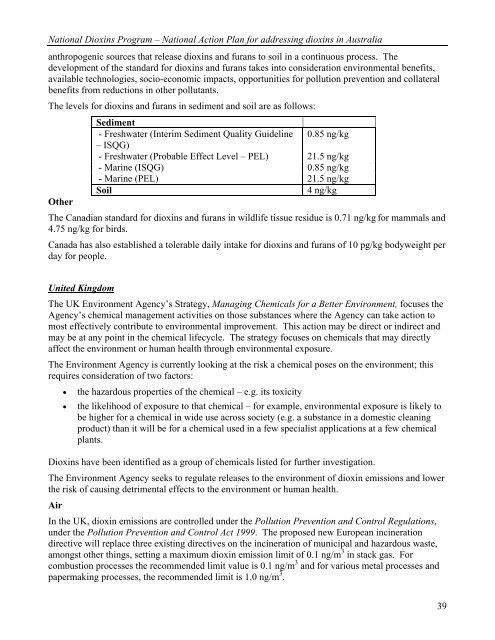National Action Plan for Addressing Dioxins in Australia
National Action Plan for Addressing Dioxins in Australia
National Action Plan for Addressing Dioxins in Australia
- No tags were found...
You also want an ePaper? Increase the reach of your titles
YUMPU automatically turns print PDFs into web optimized ePapers that Google loves.
<strong>National</strong> <strong>Diox<strong>in</strong>s</strong> Program – <strong>National</strong> <strong>Action</strong> <strong>Plan</strong> <strong>for</strong> address<strong>in</strong>g diox<strong>in</strong>s <strong>in</strong> <strong>Australia</strong>anthropogenic sources that release diox<strong>in</strong>s and furans to soil <strong>in</strong> a cont<strong>in</strong>uous process. Thedevelopment of the standard <strong>for</strong> diox<strong>in</strong>s and furans takes <strong>in</strong>to consideration environmental benefits,available technologies, socio-economic impacts, opportunities <strong>for</strong> pollution prevention and collateralbenefits from reductions <strong>in</strong> other pollutants.The levels <strong>for</strong> diox<strong>in</strong>s and furans <strong>in</strong> sediment and soil are as follows:OtherSediment- Freshwater (Interim Sediment Quality Guidel<strong>in</strong>e– ISQG)0.85 ng/kg- Freshwater (Probable Effect Level – PEL) 21.5 ng/kg- Mar<strong>in</strong>e (ISQG) 0.85 ng/kg- Mar<strong>in</strong>e (PEL) 21.5 ng/kgSoil4 ng/kgThe Canadian standard <strong>for</strong> diox<strong>in</strong>s and furans <strong>in</strong> wildlife tissue residue is 0.71 ng/kg <strong>for</strong> mammals and4.75 ng/kg <strong>for</strong> birds.Canada has also established a tolerable daily <strong>in</strong>take <strong>for</strong> diox<strong>in</strong>s and furans of 10 pg/kg bodyweight perday <strong>for</strong> people.United K<strong>in</strong>gdomThe UK Environment Agency’s Strategy, Manag<strong>in</strong>g Chemicals <strong>for</strong> a Better Environment, focuses theAgency’s chemical management activities on those substances where the Agency can take action tomost effectively contribute to environmental improvement. This action may be direct or <strong>in</strong>direct andmay be at any po<strong>in</strong>t <strong>in</strong> the chemical lifecycle. The strategy focuses on chemicals that may directlyaffect the environment or human health through environmental exposure.The Environment Agency is currently look<strong>in</strong>g at the risk a chemical poses on the environment; thisrequires consideration of two factors:• the hazardous properties of the chemical – e.g. its toxicity• the likelihood of exposure to that chemical – <strong>for</strong> example, environmental exposure is likely tobe higher <strong>for</strong> a chemical <strong>in</strong> wide use across society (e.g. a substance <strong>in</strong> a domestic clean<strong>in</strong>gproduct) than it will be <strong>for</strong> a chemical used <strong>in</strong> a few specialist applications at a few chemicalplants.<strong>Diox<strong>in</strong>s</strong> have been identified as a group of chemicals listed <strong>for</strong> further <strong>in</strong>vestigation.The Environment Agency seeks to regulate releases to the environment of diox<strong>in</strong> emissions and lowerthe risk of caus<strong>in</strong>g detrimental effects to the environment or human health.AirIn the UK, diox<strong>in</strong> emissions are controlled under the Pollution Prevention and Control Regulations,under the Pollution Prevention and Control Act 1999. The proposed new European <strong>in</strong>c<strong>in</strong>erationdirective will replace three exist<strong>in</strong>g directives on the <strong>in</strong>c<strong>in</strong>eration of municipal and hazardous waste,amongst other th<strong>in</strong>gs, sett<strong>in</strong>g a maximum diox<strong>in</strong> emission limit of 0.1 ng/m 3 <strong>in</strong> stack gas. Forcombustion processes the recommended limit value is 0.1 ng/m 3 and <strong>for</strong> various metal processes andpapermak<strong>in</strong>g processes, the recommended limit is 1.0 ng/m 3 .39
















